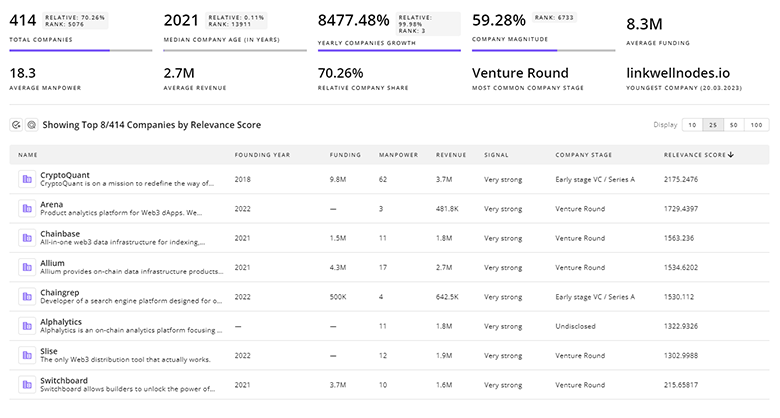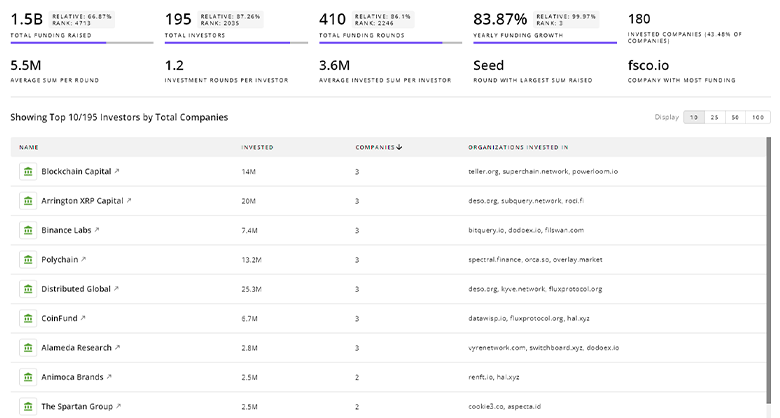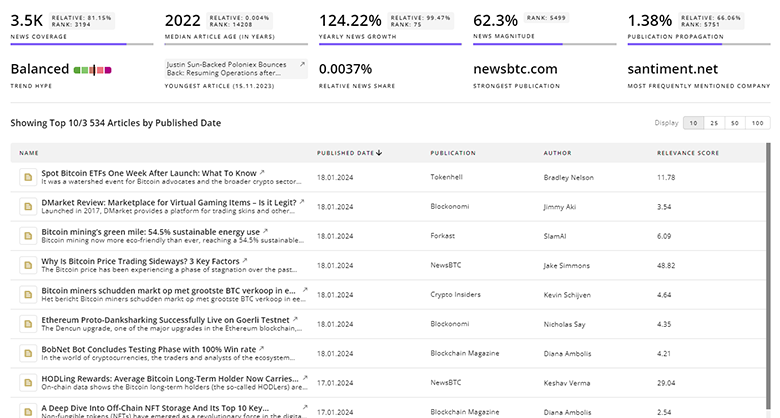
Immersive Entertainment Report
: Analysis on the Market, Trends, and TechnologiesThe immersive entertainment market shows clear commercial traction: global revenue measured at USD 25,300,000,000 in 2023 with a strong market CAGR cited at 25.1 percent in the internal trend data, indicating sizeable near-term expansion and high commercial appetite for XR experiences. Hardware refresh cycles and new headset launches accelerated consumer adoption in 2024, while location-based venues and subscription XR platforms created alternative monetization pathways that widen addressable revenue beyond home headsets Grand View Research.
The last update of this report was 67 days ago. If you spot incomplete or incorrect info, please let us know.
Topic Dominance Index of Immersive Entertainment
The Topic Dominance Index analyzes the time series distribution of published articles, founded companies, and global search data to identify the trajectory of Immersive Entertainment relative to all known Trends and Technologies.
Key Activities and Applications
- Live-event VR streaming — broadcasting concerts, sports, and theater into headsets to multiply audience reach and create premium virtual ticketing lines that sit alongside physical attendance.
- Location-based entertainment (LBE) and immersive theaters — purpose-built venues (domes, LED volume spaces, haptic pods) that combine physical staging and XR to deliver repeatable, high-ARPU experiences.
- Experiential e-commerce / iCommerce — 3D showrooms and AR try-ons that shorten purchase cycles and reduce returns by exposing shoppers to product scale and behavior in context.
- Interactive live narratives and theater — branching stories and audience agency integrated into live shows and in-seat apps that create measurable engagement metrics for promoters and sponsors.
- Immersive training and simulations — enterprise and education adoption (VR simulations, digital twins) where measurable learning outcomes justify subscription or TaaS business models MarketResearchFuture US report.
Emergent Trends and Core Insights
- AI as the production engine and runtime director: generative models and AI agents accelerate content creation, drive dynamic narratives, and enable lifelike conversational characters for games and virtual actors Journee.ai.
So what: studios can scale localized experiences and reduce traditional production lead times, shifting spend from linear production to iterative, data-driven content updates. - Platformization and cloud streaming: pixel-cloud and Cloud XR remove high-end client hardware requirements and expand distribution to browsers and low-cost headsets.
So what: companies that deliver seamless, low-latency streaming capture larger audiences and convert casual users into recurring consumers. - Sensory depth moves from novelty to competitive advantage: haptics, spatial audio, and volumetric capture increase presence and retention; patents and startups target fine-grained tactile feedback and adaptive audio to differentiate experiences.
So what: venue operators and premium content owners will pay for sensory systems that lift ticket yields and subscription ARPU. - Location-based mixed reality (LBMR) and IP-driven themed entertainment scale tourism and inbound spending in APAC and Europe, supported by public and private investments in attractions Mordor Intelligence Europe market analysis.
So what: operators that tie immersive formats to strong IP or tourism flows capture multi-visit behavior and extended-stay revenue. - Commercialization paths diversify: ticketing, subscriptions, licensing, sponsorships, training-as-a-service and iCommerce coexist; publishers cross-monetize content across LBE and home channels The Business Research Company.
Technologies and Methodologies
- Standalone, high-resolution headsets + inside-out tracking — reduce setup friction and increase consumer session frequency.
- Cloud XR / pixel streaming — stream high-fidelity 3D to low-power devices; critical for cinematic quality without expensive hardware Infinity Void.
- Volumetric capture and 6DoF video — enable believable live performers and real-time compositing in virtual venues, useful for concerts and virtual production Grand View Research immersive display report.
- Haptics and fingertip actuation — from wearable suits to local actuators for tactile effects; these technologies increase retention and perceived value of premium experiences Fluid Reality.
- Procedural and generative pipelines — AI generates 3D assets, branching narratives, and NPC behaviors; integration with Unreal Engine 5 and UEFN speeds production for both games and live activations Vmersive crea8or.STUDIO.
- No-code / low-code authoring and browser delivery — democratizes creation for brands and events while shortening time to market XR Central.
Immersive Entertainment Funding
A total of 158 Immersive Entertainment companies have received funding.
Overall, Immersive Entertainment companies have raised $22.1B.
Companies within the Immersive Entertainment domain have secured capital from 531 funding rounds.
The chart shows the funding trendline of Immersive Entertainment companies over the last 5 years
Immersive Entertainment Companies
Gamiotics
Gamiotics offers a web-based in-seat interactivity layer that lets audiences use phones to influence live shows and events, enabling immediate audience agency and real-time data capture. The company targets venues and promoters with a zero-install approach that simplifies deployment at scale and creates new sponsorable engagement metrics for live events. Its model converts passive spectators into measurable active participants, which increases ancillary revenue per event.StrikerVR
StrikerVR develops advanced haptic peripherals and controllers designed for sports-oriented and physical VR experiences, emphasizing nuanced tactile feedback that maps to gameplay and physical simulation. The startup positions hardware as a differentiator for esports, location-based arenas, and interactive installations where touch increases believability and retention. Backed by a seed/Series A funding stage, the company targets partnerships with content creators and LBE operators to bundle haptics with premium content.anitya
anitya offers a browser-native, low-code toolkit for building and publishing immersive 3D experiences, aimed at brands that need rapid deployment without in-house 3D teams. The platform integrates AI assistants for asset generation and supports multi-device delivery, lowering the cost and time to produce showrooms, campaign activations, and training modules. Its seed funding and established revenue indicate product-market fit among SMEs and enterprise marketers adopting XR for commerce and events.Imersive.io
Imersive.io provides metaverse-style iCommerce spaces and point-of-sale integrations for brands that want 3D showrooms with conventional payment flows, marrying AR/VR interfaces to real transactions. The startup targets retail brands seeking higher conversion and lower return rates via realistic product display and AR try-ons, and emphasizes affordability and ease of use for non-technical marketing teams. Its product focus solves a clear e-commerce pain point and creates a direct commercial path from immersive demo to purchase.
TrendFeedr’s Companies tool is an exhaustive resource for in-depth analysis of 723 Immersive Entertainment companies.

723 Immersive Entertainment Companies
Discover Immersive Entertainment Companies, their Funding, Manpower, Revenues, Stages, and much more
Immersive Entertainment Investors
The TrendFeedr’s investors tool features data on 734 investors and funding activities within Immersive Entertainment. This tool makes it easier to analyze complex investment patterns and assess market potential with thorough and up-to-date financial insights.

734 Immersive Entertainment Investors
Discover Immersive Entertainment Investors, Funding Rounds, Invested Amounts, and Funding Growth
Immersive Entertainment News
Stay ahead of the curve with Trendfeedr’s News feature. The tool provides access to 1.5K Immersive Entertainment. Navigate the current business landscape with historical and current Immersive Entertainment data at your fingertips.

1.5K Immersive Entertainment News Articles
Discover Latest Immersive Entertainment Articles, News Magnitude, Publication Propagation, Yearly Growth, and Strongest Publications
Executive Summary
Immersive entertainment now combines scaled consumer hardware adoption with a maturing commercial stack: cloud streaming, AI production, sensory hardware, and no-code authoring converge to make immersive experiences economically viable across consumer, enterprise, and live-venue business models. The highest near-term returns go to companies that pair compelling, IP-driven content with distribution that reduces device friction (browser or streamed delivery), add measurable secondary revenue (subscriptions, commerce, sponsorship), and deliver sensory upgrades that raise ticket yields. Investors and operators should prioritize modular technology stacks that enable multi-channel monetization and rapid content iteration while aligning with regional demand dynamics (APAC venue growth and North American platform concentration).
If you’re an expert in trends or emerging tech, we invite you to contribute to our insights.












